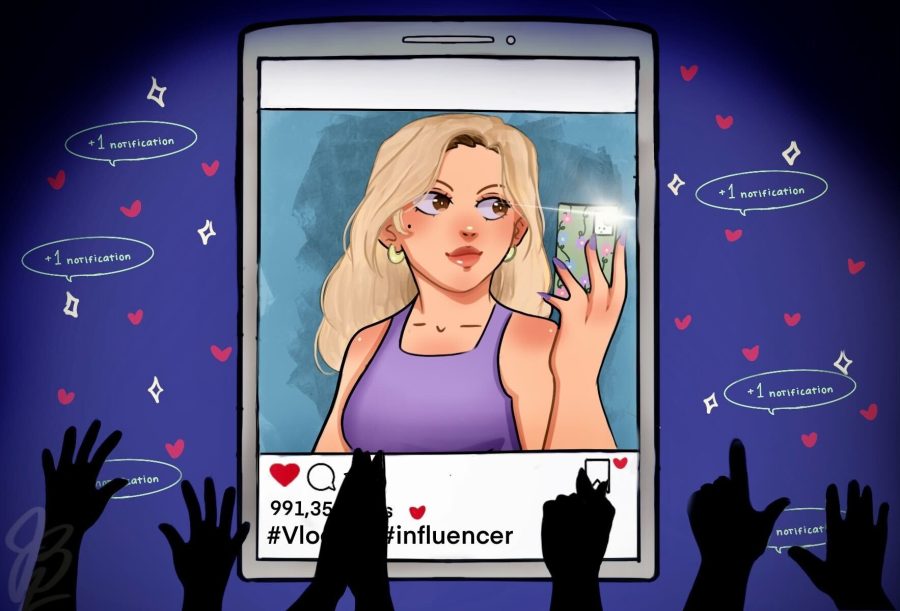Opinions writer Noor Haghighi argues that even if influencers start off posting with innocent intentions, they often quickly get endorsed by companies who turn their lives into a monetized show. This is not to say you should cut all ties with your favorite influencers, but relying on and idolizing them is a dangerous game.
It’s 2018. You’ve come home from a boring day of AP Euro lecturing and waiting for your crush to Snapchat you back. Your bed has never looked so good. You plop yourself down for what you expect will be just an hour of chill time before doing homework.
You locate YouTube on your home screen and find that Emma Chamberlain has posted a new video. In the thumbnail you see a scrunchie in her hair and a mason jar full of iced coffee in her hands.
You see her do the same thing you just did: come home from school, grab a snack, lay down and reflect on the day that’s passed. “She is so relatable,” you think to yourself. And she was.
She captured the simplicities of being a teenager: trying new foods and crafts, dying our hair and getting excited about music. She showed us how normal it was to have acne, she inspired us to buy our clothes second-hand, she made it okay to sit in front of a camera and express her vulnerability physically and emotionally.
At the end of the day, she was just a teenage girl all alone in her bedroom or car, like the rest of us.
Five years later, Chamberlain lives in a multi-million dollar home in L.A. and is no longer as relatable as she used to be. The Philz Coffee that once adorned her image is now replaced with her own line of wildly popular drinks called Chamberlain Coffee. In the last several years, she has been invited to a multitude of red-carpet events including the Met Gala and international fashion weeks alongside celebrities.
I doubt very many of her subscribers are 21-year-olds with the same luxuries. Yet what keeps the fans coming back?
Most influencers started out as teens vlogging their ordinary days. At this stage, they are like the middle ground between us regulars and celebrities. They aren’t totally out of reach, but they still give us sparks of inspiration and assure us that we are not alone. However, this period of casual influencing doesn’t last long before they are swept away by countless offers.
Chamberlain and those alike are just puppets of the influencer world being controlled by advertisements. She is a prime example of how most influencers begin posting innocently — maybe out of loneliness or as creative expression — but quickly get endorsed by companies who turn their lives into a monetized show.
Take the D’Amelio family, for instance. Charli D’Amelio began posting short dancing videos on TikTok in the spring of 2019 and has now amassed over 150 million followers at the age of 18. Her family has a reality show on Hulu and all of them — down to her four dogs — seem to have a career of their own.
It feels like nobody who is popular on YouTube or TikTok is posting just for fun anymore, and that means those on the other side of the screen cannot consume their media just for fun either. There are many costs that come with high media consumption, especially at a young, impressionable age.
The influencers themselves are not necessarily the ones in control of this system to stardom, but they are feeding it by complying and promoting the material-driven agenda of the corporate realm. This is not to say you should cut all ties with your favorite influencers, but relying on them is a dangerous game.
The effects of consuming their content on an everyday basis may go unnoticed — the thrift hauls, photo dumps and thank yous “for the birthday wishes” create only the illusion of relatability. You feel that you know this person and that they made this post for you. This practice leads us to fall into the same tendency of material-dependent happiness and what could be considered friend aversion.
Rather than finding relatability with people in real-time, we seek it from somebody who has more than us.
When thinking about the title of “influencer,” it’s a challenge to even pinpoint what makes them so influential in the first place. They are not scientists, many are not the artists or “creators” they are labeled as and they certainly are not philanthropists. The one thing they do have is attractiveness, and they typically have something that we are envious of.
I’ve tried to put myself in the shoes of influencers and think: what are they to do but agree to a huge inflow of cash in exchange for minimal work? Anyone would do the same, right?
Their compliance makes it okay for their followers to strive to do the same. The millions following influencers like Chamberlain and the D’Amelios are subject to have their individuality tarnished with the constant reminder to “buy this” and “try that,” especially when those trends are what everyone else is already playing into.
The same risk runs with the tendency of hyper-labeling. The “clean girl” look is one of the most sought-out labels circling TikTok right now. Not only is it geared toward a certain demographic (of white girls), but it also categorizes a whole bunch of girls under one style rather than encouraging them to express themselves with a fearless mindset.
Trends are one of the most problematic fuels of this influencer culture. Data shows that “YouTuber” is the most desirable career by Generation Z, and that if the “opportunity was presented to them,” over half of them would become influencers. There seems to be a delusion amongst our age group that this sort of status is attainable, but the biggest triumphs of influencing are typically handed to white women who are already well-off to begin with.
Alix Earle, one of TikTok’s most influential, has a page described by Cosmopolitan as “filled with makeup, glamorous outfits, acne updates, college lifestyle, and pure chaos[.]” Those “acne updates” do not exactly make her relatable, though. For one, it’s nearly impossible to find a video of hers where her face is not completely acne-free. Even if she does happen to address a tiny pimple on her cheek every now and then, the rest of the time she is documenting rides in private jets and parties with expensive attire.
Earle and other influencers alike are so obviously separating themselves from the rest of us who are in a lower tax bracket. But I find it frustrating that their millions of followers can’t seem to catch on.
In many cases, those followers are too young to catch on. When I was 15, I was too young to catch on myself. And, at that point, TikTok had not amassed the power it has today. With its accessibility, addictiveness and lack of age restrictions, TikTok especially makes it easy to lure in teenagers at the formative age that they are establishing their identities.
Young users cannot be blamed for the media they consume when their vulnerability is capitalized on. Still, there are users at the college age and beyond who blindly conform to influencer culture as well and it is imperative that they realize this toxicity.
There is no use in worshiping women like Earle who make it seem like the lavish life is available to anyone who wants it. They make being white and having conventionally beautiful features the expected norm. Without those features, however, you are not as desired by mainstream companies and you are not as likely to be offered the same amount of money.
This also begs the question of who we are allowing to be the role models for teenage girls today. After all, it is likely that more teens know Chamberlain’s name over, say, Malala Yousafzai’s or Greta Thunberg’s. Take it from my own Instagram friends: 103 of the people I follow on Instagram follow Chamberlain, while only 39 follow Thunberg and six follow Yousafzai.
In many ways, it is easier to follow an influencer who posts her outfits and her morning pastries over an influencer who informs and calls for action on social media. But what many do not realize is the long-term damage of idolizing Chamberlain, Earle and those alike. Their content maintains the cycle of unhealthy comparison and self-harm amongst young women. And the ones who claim to be relatable despite their unfathomable wealth are especially dangerous.
Young women should be encouraged to seek inspiration from individuals who are true influencers with the social awareness to combat injustice — rather than perpetuate it. In some cases, popular internet influencers appear progressive and encourage performative activism amongst their followers without that negatively connoted label, of course. They change their profile picture to show text that reads “Black Lives Matter” and they repost progressive infographics on their stories. But how much do they care about and contribute to such causes in private?
To them, it doesn’t seem to matter how many people suffer through adversity while they continue to be praised and given more money. Part of the fault, again, lies within the followers. Why do they applaud their internet idols for simple, oftentimes useless reposts when they could be following stories from minorities who actually experience injustice firsthand or environmentalists who actively support their cause?
At the same time that I critique influencer culture, I also wonder what its shelf life is. How many more years will we continue to scroll, flooded by sponsored day-in-the-lives and makeup tutorials? Influencing is not a guaranteed pathway and it’s not sustainable either. Once enough people attempt the influencer life and realize they stand no chance at stardom, it will fail to prosper in the way it once could.
Call me traditional, but a lot more can be done from person to person rather than from person to screen. Take a break from double-clicking and scrolling every now and then to think about which influencer is sparking your interest. They are closer to the T.V. characters you watch every day than they are to you and nothing about their lives is attainable.
It is the responsibility of us users to shift our focus on bettering the tangible world rather than dreaming of a rich girl’s heaven that only exists in our lives as pixels.
Follow the Daily Wildcat on Twitter

Noor Haghighi is a second-year student exploring ways to harness her passions in environmental science and journalism. She loves wildlife photography and portraiture, fashion, music and film.









